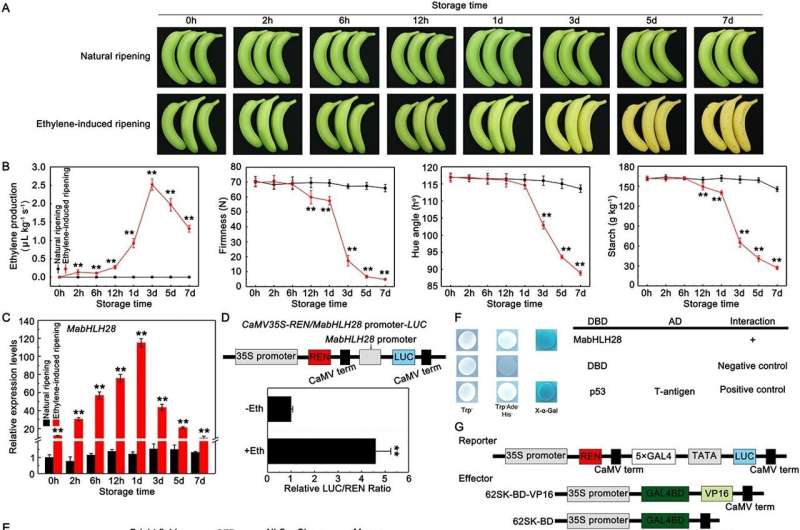This article has been reviewed according to Science X's editorial process and policies. Editors have highlighted the following attributes while ensuring the content's credibility:
fact-checked
peer-reviewed publication
trusted source
proofread
Ripe for knowledge: Unraveling the genetic ties of banana softening

A recent study has pinpointed a novel bHLH gene, MabHLH28, as a key regulator of banana fruit ripening. This gene significantly influences the softening process by upregulating the expression of softening-related genes, either independently or in synergy with MaWRKY49/111. The findings could revolutionize post-harvest fruit management, potentially reducing spoilage and extending fruit longevity.
Fruit ripening is a critical phase that determines quality, storability, and market value. Over-softening poses challenges for storage and transport, causing economic losses. The mechanisms behind fruit softening involve the coordinated regulation of cell wall modification and starch degradation genes. Due to these challenges, there is a need to explore genetic regulators like MabHLH28 for better postharvest handling of fruits.
Researchers from the State Key Laboratory for Conservation and Utilization of Subtropical Agro-bioresources at South China Agricultural University published their findings on February 23, 2024, in Horticulture Research. They discovered that the bHLH transcription factor, MabHLH28, significantly upregulates during banana ripening and directly influences the expression of genes associated with fruit softening.
The study identified MabHLH28 from transcriptomic data related to banana ripening, revealing its significant upregulation during this process. MabHLH28 binds to promoters of softening-related genes such as MaPG3, MaPE1, MaPL5, MaPL8, MaEXP1, MaEXP2, MaEXPA2, MaEXPA15, MaGWD1, and MaLSF2, thereby enhancing their expression. Electrophoretic mobility shift assays (EMSA) and dual-luciferase reporter (DLR) assays validated these bindings.
Functional experiments showed that transient overexpression of MabHLH28 in banana and tomato fruits accelerated ripening by upregulating these genes, while silencing MabHLH28 delayed the process. Furthermore, MabHLH28 interacts with transcription factors MaWRKY49 and MaWRKY111 to form protein complexes, which synergistically enhance the transcription of softening-related genes.
These findings suggest that MabHLH28 is a crucial regulator in banana fruit ripening, acting both independently and in cooperation with other transcription factors.
Dr. Xinguo Su, one of the corresponding authors, commented, "This discovery of MabHLH28's role in banana ripening is a significant step forward. By understanding these genetic pathways, we can develop new strategies to improve fruit quality and extend shelf life, benefiting both producers and consumers."
The findings of this study have practical implications for the fruit industry. By manipulating the expression of MabHLH28, it may be possible to control the ripening process, thereby improving the postharvest quality and extending the shelf life of bananas. This genetic approach offers a sustainable solution to reducing postharvest losses and ensuring better fruit quality during transport and storage.
More information: Chaojie Wu et al, Banana MabHLH28 positively regulates the expression of softening-related genes to mediate fruit ripening independently or via cooperating with MaWRKY49/111, Horticulture Research (2024). DOI: 10.1093/hr/uhae053
Journal information: Horticulture Research
Provided by NanJing Agricultural University


















